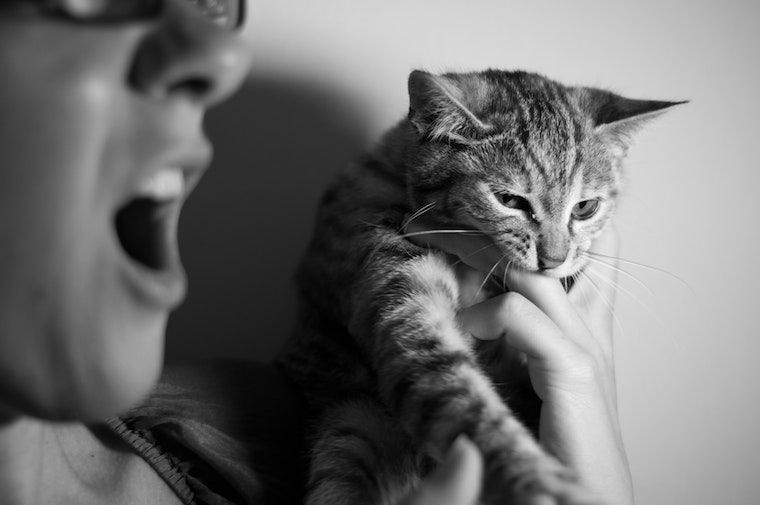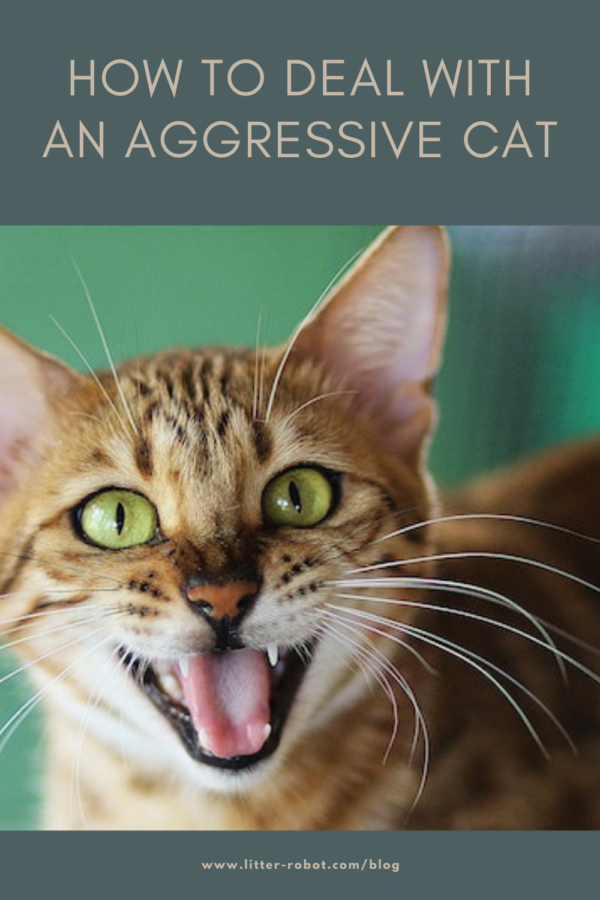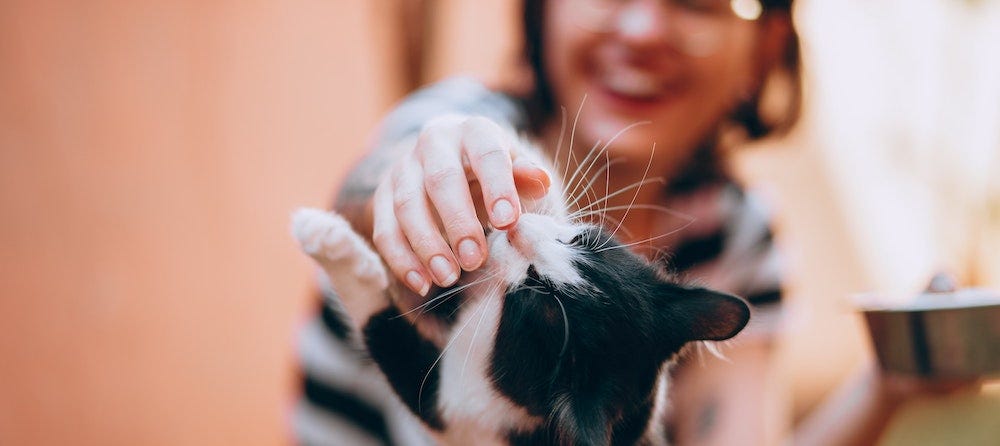In this two-part blog, Dr. Justine Lee, DACVECC, DABT reviews how to deal with an already aggressive cat. Tune in next month to read more about how to prevent aggression in cats!
If you’ve ever left your windows open at night, you may have been awakened to the terror-invoking sounds of a tomcat fight. The loud hissing, spitting, growling, and shrieking is enough to make this veterinarian scared! Most of the time, outdoor “cat brawls” are due to sex hormones (like testosterone) and the territorial nature of tomcats.
But what about our loveable indoor house cats?
As a veterinarian, I still see aggression in cats—even after cats have been spayed or neutered. Sadly, a recent study found that over 25% of cats surrendered to shelters were for behavior reasons related to aggression.
Types of cat aggression
Keep in mind that there are several different “types” of aggression in cats, including the following below (in alphabetical order):
- Fear Aggression
- Inter-Cat Aggression
- Maternal Aggression
- Pain-Induced Aggression
- Petting-Induced Aggression
- Play Aggression
- Redirected Aggression
- Status-Induced Aggression
- Territorial Aggression
How you deal with an aggressive cat will depend on what type of aggression your cat has.
Signs of an aggressive cat
First, let’s define what an aggressive cat looks like, because sometimes it can be confused with a fearful cat! It’s important to be aware of signs of aggression in cats, because the sooner you notice your cat’s body language of stress or aggression, the sooner you can break it up or intervene.
Signs of aggression in cats include:
- Ears pinned backward on the head
- Dilated pupils
- An arched back
- A fluffed tail held straight up
- Whiskers held out to the side
This looks similar to fearful cats, but note the differences with fear:
- Ears pinned back and held outward
- Dilated pupils
- Lying down with the tail tucked underneath or close to the body
- Whiskers flattened against the face
Now that you understand the body language of cats and know what to look for, please be aware there are several things you can do at home to deal with an aggressive cat.
How to deal with an aggressive cat

First, intervene early.
The best way to avoid dealing with an aggressive cat is to prevent it. As a species, cats aren’t very adaptable. They hate any change to their environment and get easily stressed from it, which can lead to secondary behavioral—or even medical—problems. For that reason, if you’re thinking about adding cats to your household, ideally you want to get two kittens together from the same litter, as they are more likely to get along. If you don’t have a preference for male or female, consider getting two of the same sex, as they often get along better!
Not ready for two kittens? Adding a cat earlier than later is better, as younger cats are more likely to get along than when there’s a large disparity in age or time. If they aren’t littermates, consider a younger male and female, as they often get along better. Avoid the problem of having an aggressive cat to begin with by intervening early.
Second, make sure to introduce cats correctly.
First impressions really matter to cats—you want the introduction to go slowly and go well. If you don’t introduce cats correctly, a lifetime of cat fighting or aggression can ensue, and it’ll be more challenging to get them to give the other cat a second chance. If for some reason you notice aggression between two particular cats, you should separate them and start all over again.
Slowly reintroduce them using positive reinforcement and barriers as needed. Start by setting up each of your cats in their own space. This should be behind closed doors where the other cat can’t go. Once or twice a day, rotate home base stations for an hour or two. Eventually, use a barrier to let them check each other out. When in doubt, go slow. Remember, first impressions are REALLY key for cats.
Third, use appropriate behavioral modification at home.
I’m a big believer in positive reinforcement—like snacks, snacks, and more snacks. And we want the good stuff, like canned tuna, Temptations© treats, bonito flakes, and Churu© purees. This is stuff that you only whip out for special occasions—like making your cats get along! Keep in mind that we use these treats as a way of showing positive reinforcement: When cats sniff out the cat space without hissing, or have a calm, stress-free interaction, give them a treat immediately. If you wait too long (even 5 minutes later) it’s too far of a time gap and your cat won’t make the direct connection with calm behavior and a treat.
Veterinary professionals and veterinary behaviorists don’t advocate for negative reinforcement with cats (or dogs—please never use physical punishment). Not only can this make your cat avoid you altogether, but it can potentially make your cat’s behavior worse. The rare exception: For very young kittens, you can consider little snaps on the muzzle and scratching the belly when they are uncontrollable or showing signs of aggression. These are actions the mother or littermates would use to help socialize the rowdy kitten!
Fourth: Just say yes to drugs.
The behavioral kind, that is! If you’ve worked to help make an appropriate cat introduction or you’ve tried using appropriate behavioral modification and your cat is still attacking people or other animals, please talk to your veterinarian. That’s because we may recommend medications: There are several options, from over-the-counter holistic natural supplements to veterinary-prescribed medications… and these can work wonders on an aggressive cat!
One of my favorite, easiest ways to start treating cat aggression is with cat pheromones (like Feliway©), which you can purchase from your veterinarian or online. Pheromones are a great, cost-effective, safe way of positively influencing your cat’s behavior, as pheromones can ease a cat’s anxiety, reduce stress and stress-related behavior, and help with behavioral problems (like aggression, fighting, etc.). Feline pheromones typically are sold as a wall plug-in, spray (not to be used on your cat directly!), a wipe (on a disposable cloth), or even a collar. In some cases, pheromones alone can solve behavioral issues depending on the severity.
But what do you do if there’s no improvement in your cat’s aggression? Next, you can consider some holistic supplements! I recommend veterinary supplements such as brands like Zylkene© and Solliquin©. Zylkene©, which contains alpha-casozepine, helps treat fear, anxiety, and stress in cats (it’s a once-a-day pill). Solliquin©, which contains l-theanine, phellodendron, and magnolia, can be used twice a day in cats to help support balanced behavior and relaxation.
While CBD options are being explored for cats, please be aware that most cats drool profusely when they get oral CBD—so at this time, I’m not a fan of CBD for cats!
OK, so you’ve tried some of these more “natural” pheromones or supplements. Still have an aggressive cat?
Fifth: A veterinary consult and examination!
If you’ve tried all that and your cat is still aggressive, a vet check is a must. Sometimes, they’ll give you advice on environmental modifications to implement. Sometimes it's as simple as making sure that a cat has access to additional clean litter boxes, that food and water sources are appropriately placed throughout the house, or providing access to a climbing perch or the ability to look out the window. However, we need to make sure there aren’t any medical problems that are causing the aggression or altered behavior. Sometimes an ear infection, sore mouth/infected tooth, urinary tract infection, bladder stones, osteoarthritis, overactive thyroid gland, or even secondary pain may be causing the aggression. Once underlying medical problems have been ruled out, a vet-recommended behavioral prescription medication may be necessary.
Prescription medications
Prescription medications often include selective-serotonin reuptake inhibitor (called SSRI) antidepressants; these drugs work by providing more serotonin in the body to relax your cat, and help make your cat calmer, less fearful, and less aggressive. Yes, this is the equivalent of cat Prozac©. Sometimes, benzodiazepines can be considered to treat aggression in cats, although, some types like Valium© have been associated with causing severe liver injury in cats (which is why you should never give YOUR medications to your cat!).
Some cat parents are hesitant to medicate their cat. However, keep in mind that it may be better for your cat’s welfare if the aggression is severe. Other medications may include oral sedatives—these are used more for travel or stress-related matters and include classes of drugs like gabapentin or trazodone. These cause sedation and are really only used prior to veterinary visits, groomer visits, or changes in environment (like if you have family visiting for the holidays, are moving, etc.).
Please know that when using these medications, you will have to work with your veterinarian on adjusting the dosing of these medications, as sometimes the higher range of the dose needs to be adjusted, or another type of medication needs to be considered (or even added in!). When using oral medications to reduce aggression in your cat, please be aware that it should also be in combination with behavioral and/or environmental modification to be successful. When in doubt, it’s ok to “say yes to drugs,” as it’ll keep everyone in the household much happier and safer!
Lastly, consult a veterinary behaviorist.
OK, you’ve tried it all. You’ve gone to your vet. Your cat is on drugs. And it’s still not working? It’s time for a pro: the veterinary behaviorist. This isn’t an online trainer—this is a veterinarian who has done an additional 2-3 years of advanced training in the form of a residency program. These are veterinarians who have the added letters DACVB behind their name, as this stands for a Diplomate of the American College of Veterinary Behavior. While veterinary behaviorists often work with animal trainers—and your veterinarian—these are the pros to go to with severe cases of cat aggression that aren’t responding to the above care. (You can also check out their recent book Decoding Your Cat for general training guidelines for cats too!).
Next month, we’ll talk about what else you can do to help prevent aggression in cats. Tune into Part 2 for more!
Cover photo by Kim Davies on Unsplash









